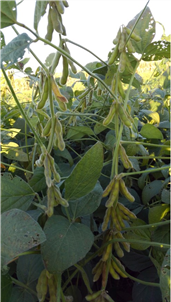Soybean yield is determined largely by number of seeds per acre. The more seeds the bigger the yield. Seed size and weight also plays a smaller role in final yield.
Seed number per acre is largely determined by pods per plant and acre. And yes, seed number per pod has an effect, but like seed weight, it’s a smaller component. In my experience if you track seeds per pod across a plant and field it will range from 2.5 to 3 seeds per pod. Sure, you will find a 1-bean pod at the top, 4-bean pods and sometimes a 5-bean pod, but that is out of the ordinary. What is important is number of pods per acre.
Pod set on soybeans varies and is related to row spacing, population, node number and retention. The higher the population and the wider the row, the more plants per row and the fewer pods per plant, but the number of pods per row will remain similar. Pod number per plant, though, is also determined by node number per plant. A greater number of nodes on a plant usually means more pods. Planting soybeans early means greater node set and eventual pod set. And when double-cropping soybeans, planting in narrow rows (7.5 to 15-inch at high population of 180,000 – 200,000) helps maximize the number of nodes with late planting.

Summer solstice on June 21 is the longest day of the year and we have long thought that soybean flowering begins after that day. It is true that soybean flowering does respond as nights get long (and days get shorter), but solstice no long automatically triggers the flowering in soybeans. With early planting growers are seeing flowers 1 – 2 weeks ahead of solstice; throw in warm temperatures on top of that and beans flower 2 – 3 weeks ahead of solstice. The belief that flowering begins only on summer solstice is a fallacy. Shawn Conley, University of Wisconsin soybean specialist, debunked that myth in his recent article The Soybean Flowering – Summer Solstice Fallacy.
Soybeans flower earlier than we thought so that means pod set should be sooner and perhaps greater. I asked Dr. Below, University of Illinois crop physiologist this question: If one plants soybeans on April 15, May 1, May 15 and June 1, what would be the node count at summer solstice. Below said he could answer with some speculation. “Obviously, the node numbers, as a function of planting date, could change depending on the temperatures, and while soybeans are photoperiod sensitive, it’s phenology during vegetative growth is fairly closely related to accumulated heat units. The respective growth stages at solstice (growth stage equates to node number) as a function of planting date are: April 15 (V7), May 1 (V6), May 15 (V5) and June 1 (V3). These could obviously change a stage in either direction depending on the average daily temperatures.”
Below added that the optimal node number on June 21 is 6 or more nodes and 18 – 20 at the end of flowering (early August). “Total node number is affected by the relative maturity, with the longer RM varieties typically having 1 – 3 more nodes. However, we still don’t have concrete data on these planting date questions as they relate to node and final pod count.
If you are interested in increasing soybean yield the basic metric is still bushels/A at the end of the season. However, if you are keen to begin to see incremental increases and understand why, tracking node count is a good place to start.
Soybean agronomist Daniel Davidson, Ph.D. posts blogs on agronomy-related topics. Feel free to contact him at djdavidson@agwrite.com or ring him at 402-649-5919.




 and then
and then